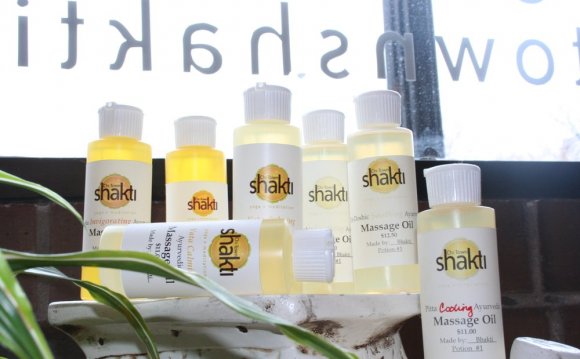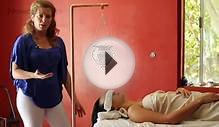
The body of one who uses oil massage regularly does not become affected much, even if subjected to accidental injuries or strenuous work. By using oil massage daily, a person is endowed with pleasant touch, trimmed body parts, and becomes strong, charming and least affected by old age. — Charaka Samhita: Sutrasthana: V: 88-89
Abhyanga should be resorted to daily. It wards off old age, exertion and aggravation of vata. — Ashtanga Hrdayam: Sutrasthana: II: 8-9
Abhyanga is the anointing of the body with oil. Often infused with herbs and usually warm, the oil is massaged into the entire body before bathing. It can be beneficial for maintaining health and is used therapeutically for certain disorders. Abhyanga can be incorporated into a routine appropriate for almost everyone.
The Sanskrit word sneha means both “oil” and “love, ” and the effects of abhyanga are similar to being saturated with love. Both experiences can give a deep feeling of stability, warmth and comfort. Sneha – oil and love – is sukshma, or “subtle.” This allows it to pass through minute channels in the body and penetrate deep layers of tissue.
Ayurveda teaches that there are seven dhatus, or layers of tissue in the body. Each is successively more concentrated and life-giving. It is taught that for the effects of sneha to reach to the deepest layer, it should be massaged into the body for 800 matras, roughly five minutes. If we consider that the entire body needs this kind of attention, a 15-minute massage is the suggested minimum amount of time.
Benefits of External Oleation
(Outlined in: Charaka Samhita, Sushruta Samhita and Ashtanga Hrdayam, the great three Classical Ayurvedic Texts)
Benefits of applying oil to the body (abhyanga):
- Imparts softness, strength and color to the body
- Decreases the effects of aging
- Bestows good vision
- Nourishes the body
- Increases longevity
- Benefits sleep patterns
- Benefits skin
- Strengthens the body’s tolerance
- Imparts a firmness to the limbs
- Imparts tone and vigor to the dhatus (tissues) of the body
- Stimulates the internal organs of the body, increasing circulation
- Pacifies vata and pitta
Herbal oils specific to your constitution or current condition are especially good choices for full body massage. Specific oil recommendations for each dosha are listed in the dosha-specific abhyanga sections below.
Benefits of applying oil to the scalp (murdha taila):
- Makes hair grow luxurious, thick, soft and glossy
- Soothes and invigorates the sense organs
- Helps reduce facial wrinkles
Bhringaraj Oil, Brahmi Oil, and Healthy Hair Oil are especially well suited for scalp massage.
Benefits of applying oil to the ears (karna puran):
- Benefits disorders in and of the ear that are due to increased vata
- Benefits stiff neck
- Benefits stiffness in the jaw
Benefits of applying oil to the feet (padaghata):
- Alleviates coarseness, stiffness, roughness, fatigue and numbness of the feet
- Feet become strong and firm
- Enhances vision
- Pacifies vata
- Benefits local tissues, veins and ligaments
Bhringaraj Oil and Brahmi Oil are especially well suited for foot massage.
Massaging oil into the human organism imparts a tone and vigor to its tissues in the same manner as water furnishes the roots of a tree or a plant with the necessary nutritive elements, and fosters its growth, when poured into the soil where it grows. The use of oil at a bath causes the oil to penetrate into the system… and thus soothes and invigorates the body with its own essence.
Under the circumstances, massages and anointments of the body with oil or clarified butter should be prescribed by an intelligent person with due regard to one’s habit, congeniality and temperament and to the climate and the season of the year as well as to the preponderance of the deranged dosha or doshas in one’s physical constitution. — Sushruta Samhita, Chikitsa Sthanam: XXIV: 29-32
These passages make it clear that we should consider our prakriti (constitution), vikriti (current condition) and our external environment in deciding which oils are best for us and how often we should perform abhyanga. While abhyanga is beneficial for most people, there are some who should avoid it.
When NOT to Do Abhyanga
- During the menstrual cycle
Massage with deep pressure during the menstrual cycle is not advised in Ayurveda, as it can initiate a release of ama (toxins) from deep tissues at a time when the body is already a bit taxed. Some women don’t like to stop abhyanga during their cycle because they have very dry skin. If you choose to do it during your cycle, it is best to apply the oil gently and for only about 5 minutes. - During pregnancy
The reasoning is similar here. It is not a good idea to stimulate any sort of detox process during pregnancy. This precaution protects the growing embryo and fetus against any unnecessary exposure to ama. - Over swollen, painful areas or masses on the body
(Or do so only with the knowledge and consent of your health-care practitioner). - Over infected or broken skin
- When there is high ama or great physical discomfort
A thick, white coating on the tongue often indicates high levels of ama. - During any sort of acute illness such as fever, chills, flu, or acute indigestion
- Directly after taking emetics or purgatives
- When you have a medical condition
(Unless your health-care practitioner says it is okay to do abhyanga).
You should not experience any uncomfortable effects with or from abhyanga. In the unlikely case that you do experience some, if you are not sure whether you should be doing abhyanga, or if you don’t know which oil to use, it is important to consult with an Ayurvedic practitioner.
Provided you do not have any of the above contraindications for abhyanga, it is time to learn which oils would be best for you. Ayurveda teaches us that like increases like and that opposites balance, so this decision should take into account the qualities influencing your constitution, your current condition, and the season.
First it is good to consider your vikriti – or current condition. If you currently have a dosha that is high, it is beneficial to follow a dosha-pacifying abhyanga for that dosha. For example, if you are nervous, anxious, and you feel cold and dry, vata is likely to be high in your vikriti and using a vata pacifying oil for your abhyanga would be most beneficial. If you are not sure of your current condition, you can take the vikriti test.
If none of your doshas are currently out of balance, it is good to consider the dominant doshas in your prakriti – or personal constitution – and your environment, including the current season and weather. For example, if you are feeling healthy and pitta is your dominant dosha, and if the weather is hot and humid (which tends to aggravate pitta) it would generally be best to choose a pitta pacifying oil. If you don’t know your Ayurvedic constitution, you can take the prakriti test.
If you have more than one dominant dosha in your prakriti, you will want to pacify doshas according to season. For example, if you have a pitta-kapha combination, it is generally best to pacify pitta during warm weather and kapha during cooler weather. If you are a pitta-vata combination, pacify pitta during warm weather, and vata in cooler weather, and during the change of seasons. If you are a vata-kapha combination, pacify vata during cold and dry weather and during the change of seasons, and pacify kapha during cold and wet weather. More extensive guidelines for each dosha are outlined below.
RELATED VIDEO












